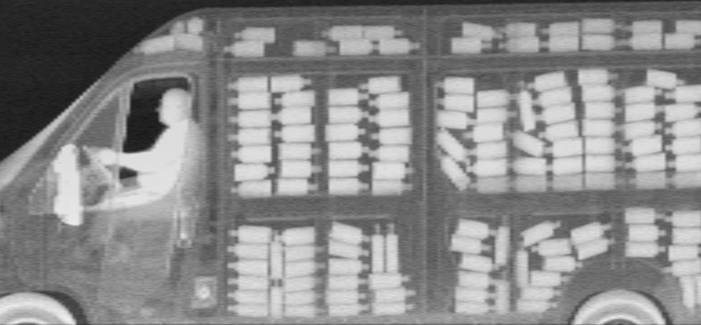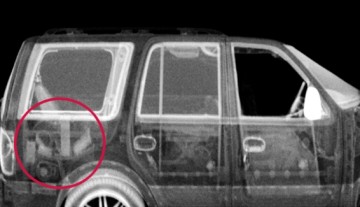
Pioneered and perfected by Rapiscan and our affiliates, Z Backscatter technology is the proven approach for discrimination of organic materials such as explosives, drugs, cigarettes, and people—especially when hidden within a complex environment.
Z Backscatter Technology
Z Backscatter images are photo-like and easy to interpret, revealing both the presence and exact position of organic components of the scanned object. It is the most effective X-ray technology for the detection of organic materials.
How X-rays Work
When X-rays interact with matter, they do one of three things:
- Pass through the object
- Get absorbed by the object
- Scatter from the object
Objects with higher density absorb more X-rays than objects with lesser density. Much organic material is low-density and X-rays scatter when they interact with organic objects.
Traditional transmission X-ray images like medical X-rays result when X-rays pass through an object to a detector located on the far side of the object. The resulting image is bright where most of the X-rays pass through the object and dark where most X-rays are absorbed.
Z Backscatter technology captures the data from the X-rays that are scattered away from the object, back towards a near-sided detector. This primary scattering effect is known as “Compton Scattering.” The Z Backscatter image is bright white where X-rays scatter the strongest, indicating organic matter, such as explosive material and drugs. Even inorganic objects, such as metals, are given shape and form in Z Backscatter images.

Z Backscatter image of a vehicle highlights concealed drugs in the rear panel.
The difference with Z Backscatter
We create photo-like Z Backscatter images showing organic materials by directing a sweeping beam of X-rays at the object under examination, and then measuring and plotting the intensity of scattered X-rays as a function of the beam position. This is made possible by patented “Flying Spot” technology. Flying Spot technology allows the position of the X-ray beam to be defined at every instant. So any Z Backscatter signal received is easily correlated with the precise region of the object undergoing inspection.
Z Backscatter's photo-like images are easy-to-interpret, revealing both the presence and exact position of organic components of the inspected object. This significantly enhances the ability of operators to quickly understand and interpret scan results.
Combination of technologies
Because of the complementary nature of transmission imaging, which reveals metallic threats, and Z Backscatter imaging, which highlights organic threats, many of our products offer a combination of these technologies. With both Z Backscatter and transmission imaging, inspectors get more richly detailed information about the contents of the object under inspection for greater detection capabilities.

Combinational imaging of a vehicle with Z Backscatter X-ray that highlights concealed organic threats and Transmission X-ray that reveals hidden weapons.

